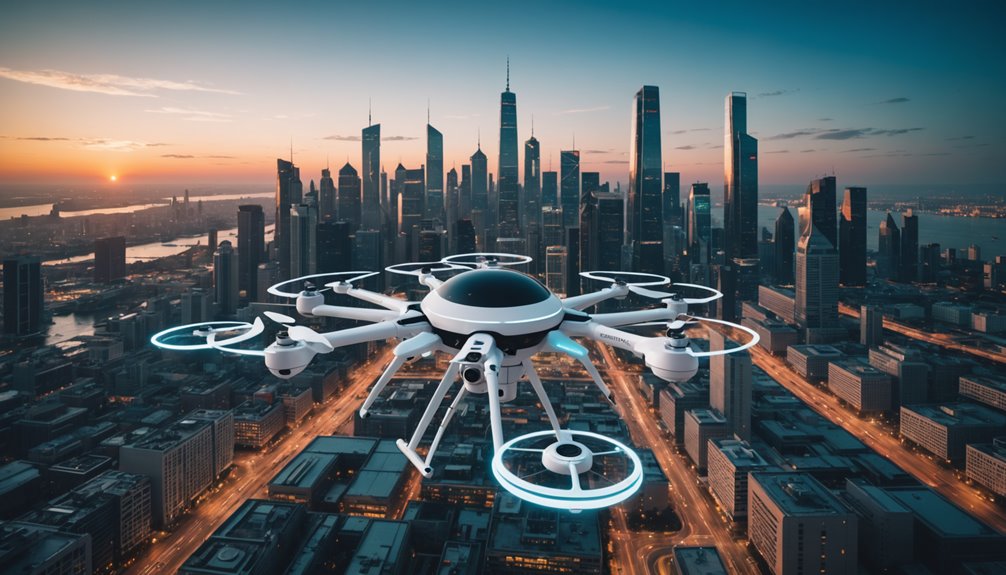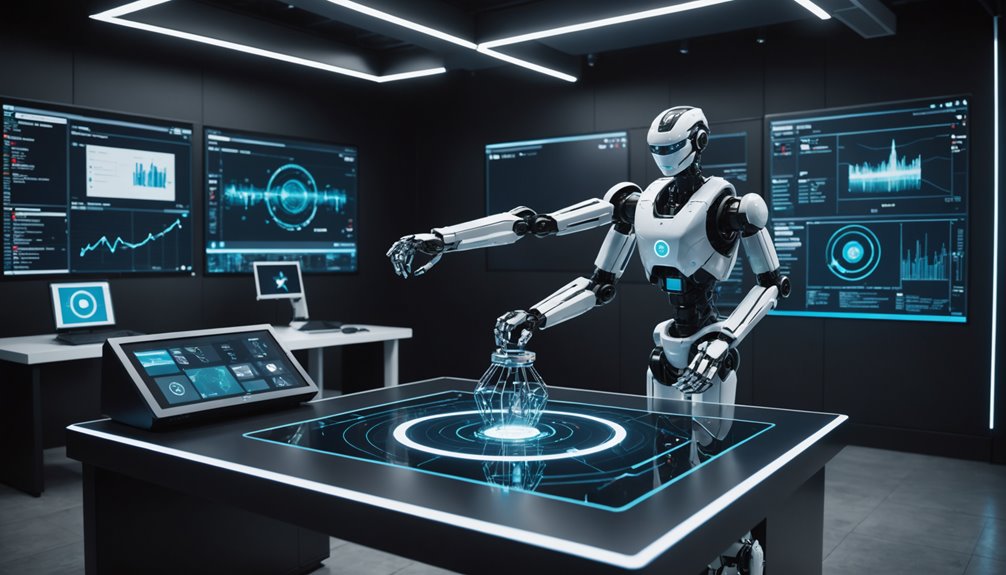Unlock the Power of Artificial Intelligence for Business
By 2025, artificial intelligence for business will redefine how companies operate, making tasks faster and decisions smarter. AI can streamline operations, cut costs, and improve customer satisfaction. From predictive analytics that forecast trends to automated systems that engage with customers, AI tools help businesses achieve more in less time.
Business owners, marketing executives, and CEOs—if you aren’t using artificial intelligence for business, you risk falling behind competitors. AI can optimize inventory, predict customer needs, and even transform how teams collaborate. Staying competitive means embracing these tools now, not later.
The possibilities with AI are growing, including future breakthroughs like quantum computing integration. An experienced AI expert can show how these innovations fit your business, helping you grow faster and work smarter. Don’t wait—explore AI today to stay ahead.
Transforming Business with Artificial Intelligence: LaunchedKey Takeaways
- AI will significantly transform customer service, with 80% of organizations expected to utilize AI-powered chatbots and virtual assistants.
- Predictive analytics in AI will offer advanced trend forecasting, reducing inventory costs and facilitating proactive asset maintenance.
- AI implementation will automate routine tasks, optimize business operations, and lead to significant cost and time savings.
- Ethical considerations and workforce impacts will be critical challenges in implementing AI, requiring strategic planning and continuous assessment.
- Anticipated AI trends include enhanced predictive analytics, integration with quantum computing, and revolutionizing customer service and digital commerce.
AI Enhancing Business Efficiency
In today’s rapidly evolving business landscape, artificial intelligence (AI) is pivotal in enhancing business efficiency. AI-driven automation is redefining industries by automating routine tasks, streamlining financial operations, and elevating customer service. It is optimizing supply chain management and revolutionizing productivity standards. Such advancements in AI automation are freeing workforce resources to focus on strategic areas, consequently enabling businesses to scale up rapidly.
Simultaneously, AI’s capacity for data processing is supercharging decision-making. The power to analyze massive data sets is delivering faster, more precise decisions, predictive analytics, and market analysis. AI’s ability to forecast revenue and identify potential risks is ensuring a more secure future for businesses.
Moreover, the advent of AI-driven customization is redefining customer experiences. By analyzing immediate consumer behavior and delivering hyper-tailored experiences, AI is enhancing brand engagement and customer loyalty. AI-powered content creation tools are enabling businesses to communicate more effectively with their audience.
A critical aspect of AI application is in sales, where automation tools like AI and chatbots are being used to efficiently handle routine inquiries, leading to improved response times and lead conversion rates. This application of AI has led to significant revenue growth in sales-focused businesses.
However, as businesses increasingly adopt AI, challenges such as ethical considerations and strategic implementation need to be addressed. Strategies like running pilot programs, creating cross-functional teams, and continuous assessment are proving effective in integrating AI successfully.
Time and Cost Savings With AI
While the integration of AI is reshaping the way businesses operate and engage with customers, a significant aspect of this digital revolution lies in its ability to generate substantial time and cost savings.
AI’s ability to streamline tasks, improve operational efficiency, reduce administrative burden, and enhance strategic planning leads to remarkable time-saving benefits. It automates routine tasks such as data entry, document processing, and customer inquiries, freeing up valuable time for employees to focus on more strategic initiatives. Additionally, AI’s predictive analytics and data-driven insights enable businesses to make informed decisions swiftly, thereby reducing time to market and increasing productivity.
In terms of cost savings, AI optimizes spending rather than merely cutting costs. It allows businesses to allocate resources more effectively by predicting needs, reducing waste, and improving operational efficiency. From streamlining IT infrastructure to preventing fraudulent activities, AI helps companies to identify and eliminate unnecessary expenses. Furthermore, AI’s efficiency gains, especially in process automation and data management, result in significant cost reductions.
Moreover, AI aids in tailoring marketing messages and personalizing recommendations to customers, thereby enhancing customer engagement and driving up purchase rates (Personalization and Customer Engagement). This is evident in the way businesses are using AI for sales automation, leading to an increase in revenue by up to 10% (Revenue Increase). In a society that craves freedom, AI offers businesses the liberty to allocate their resources more strategically, paving the way for a more efficient and profitable future.
Role of Edge AI in Business

As we venture deeper into the technological metamorphosis of the business landscape, the role of Edge AI emerges as a powerful instrument for operational efficiency and authentic-time decision-making. This groundbreaking technology optimizes operations across diverse sectors, including manufacturing and logistics, fostering quicker insights and fostering inventive customer experiences.
Boosting its appeal further, Edge AI champions data privacy by processing data locally, thereby reducing reliance on centralized data hubs. It propels industries such as energy towards predictive maintenance models, which hold immense promise for improving grid resilience. Integrating strategies like sales automation could elevate the effectiveness of Edge AI by enhancing efficiency and precise data management. Moreover, it is anticipated that by 2025, edge computing will expand significantly with the growth of AI and IoT, thus making it an integral player in the future of businesses (edge computing expansion).
The future of Edge AI is vibrant, with projections of integration into consumer devices and an expected surge in investment and M&A activities.
| Key Trends | Benefits | Future Projections |
|---|---|---|
| Market growth and widespread adoption across sectors | Immediate decision-making and improved customer experience | Integration in consumer devices and increased investment activities |
| Benefiting cloud computing, technology consulting, data center infrastructure providers | Enhanced security and privacy, increased operational efficiency | Benefits for component suppliers and vendors, increased M&A activity |
| Enabling use cases in video analytics, robotics, AI-driven customer service | Shift to predictive maintenance in the energy sector | Tailored AI chips and software-defined edge solutions |
| Need for responsive and adaptive network infrastructure | Supporting individualized experiences through smart devices | Accelerating edge AI adoption through neural processing units in PCs and smartphones
Predictive Analytics: AI’s Magic Wand
Predictive analytics utilizes the power of artificial intelligence, the magic wand that businesses in the online era have been seeking. This technology utilizes historical data and machine learning algorithms to forecast future trends, providing businesses with critical insights to make data-driven decisions and strategies.
In sales and demand forecasting, predictive analytics optimizes inventory levels, reduces costs, and refines supply chain demands. It’s a tool that facilitates a forward-thinking approach, allowing companies to anticipate customer behavior, manage risks effectively, and prevent machinery breakdowns. Financial institutions utilize predictive analytics for stress testing loan portfolios under diverse economic conditions, thereby mitigating potential losses.
In asset optimization, predictive analytics integrates with Internet of Things (IoT) technology to anticipate maintenance needs, reduce downtime, and extend asset lifespan. Predictive models support decision-making processes and strategy formulation, automating repetitive tasks to improve operational efficiency.
With the integration of AI, businesses can leverage automation in their lead generation processes, enhancing efficiency and precision and enabling sales teams to focus on strategic tasks rather than repetitive ones, automation, and data analysis.
In essence, predictive analytics powered by AI gives businesses the freedom to stay ahead, enabling them to navigate the dynamic online environment with confidence and precision. It truly is the magic wand of the future, transforming the way businesses operate and thrive.
Customer Service Transformation Through AI

In customer service, artificial intelligence is the catalyst for a profound transformation. As a potent tool for efficiency, AI improves automation, enabling businesses to focus on complex customer needs while simultaneously reducing operational costs. Agents’ productivity soars as AI takes over tedious tasks, deliver intelligent recommendations and expedites resolution times.
The power of AI in customizing customer experiences cannot be overstated. By integrating customer histories, AI provides contextual recommendations, anticipates customer needs, and offers proactive support. This level of customization not only improves the quality of service but also fosters customer loyalty. Furthermore, the use of AI in sales automation can lead to a substantial increase in productivity by up to 30%. It can save up to 9 hours per salesperson per week, thereby enhancing workflow efficiency (enhancing workflow efficiency).
Advanced AI technologies, such as generative AI and conversational AI, revolutionize customer service by creating nuanced conversations and reducing wait times. Coupled with speech and sentiment analytics, AI optimizes operations and equips agents with immediate support and guidance.
Looking ahead, projections for 2025 anticipate 80% of customer service organizations employing AI to improve experiences and productivity. As AI evolves to understand emotions, systems will tailor responses with empathy, ensuring continuous improvement in customer service. This transformation marks a new era of AI-driven customer excellence. Moreover, the integration of AI in customer service is expected to lead to substantial cost reductions and better ROI, allowing businesses to reinvest strategically for further growth (cost reductions and better ROI).
Instant Responses and AI
Utilizing the power of Artificial Intelligence, businesses are now able to deliver instant responses, revolutionizing the speed and efficiency of customer service. This technology, especially AI chatbots, markedly reduces response times and amplifies customer satisfaction by providing immediate support. Moreover, implementing AI allows for a multichannel approach in customer service, broadening reach and enhancing lead conversion.
AI’s ability to automate routine tasks not only cuts costs but also frees up personnel for strategic work, improving overall productivity. The immediate data analysis offered by AI provides practical insights into customer preferences, sales forecasting, and deal velocity, facilitating informed decision-making.
Moreover, AI’s role in complex problem-solving cannot be overstated. Through Retrieval-Augmented Generation (RAG), AI can generate super-relevant answers in real time, improving accuracy and delivering tailored solutions specific to each inquiry. With RAG’s dual approach, combining retrieval and generative tasks, AI can excel in tasks requiring precise information retrieval and coherent text generation, providing a higher level of accuracy and relevance.
The future of AI in instant responses promises even more incredible advancements. With improved individualization, integration with Internet of Things (IoT) devices, and compliance with data protection regulations, AI is primed for expansion across industries. Anticipating potential issues and optimizing resource management through predictive maintenance, AI will undoubtedly continue to be a game-changer in the world of business.
AI and Content Creation

The landscape of content creation is undergoing a seismic shift, driven primarily by the surge in Artificial Intelligence. By 2025, it is anticipated that 90% of online content will be AI-generated, facilitated by increasingly sophisticated tools. These advancements enable small businesses to enhance operations and marketing while ensuring quality, brand consistency, and ethical considerations remain under personal oversight.
AI-driven content creation offers numerous benefits. Efficiency and productivity gains are evident, with AI tools generating content faster and at scale, reducing costs compared to traditional methods. They also aid in overcoming creative blocks and improving content quality, optimizing for search engines, readability, and engagement. Multilingual capabilities further widen reach and impact. Moreover, the use of AI in managing missed calls could provide significant operational efficiency, potentially saving businesses considerable revenue loss due to missed calls.
Essential tools include StoryChief, Meta AI, Anthropic’s Claude, Syllabi, and AIPower, each offering distinctive solutions. However, it’s vital to acknowledge the limitations of AI in content creation, such as the inability to provide emotional depth or original ideas (limitations of AI). Looking ahead, generative AI is set to form a significant component of marketing strategies, with hyper-personalization and authentic-time optimization poised to transform campaigns. As AI continues to scale creative processes, we can expect further advancements in AI-driven solutions. The future of AI and content creation is bright, promising unmatched freedom in business operations.
Virtual Assistants: Next-Gen Customer Service
Emerging as game-changers in customer service, AI virtual assistants (VAs) are revolutionizing the way businesses interact with their clients. As we look towards 2025, the transformation is only set to deepen as VAs become more integral to delivering seamless customer experiences.
VAs are not just about efficiency or cost-saving; they are essential for establishing a new paradigm of customer service. This manifests in several ways:
- With AI-powered tools, AI VAs provide 24/7 support, offering a degree of reliability and consistency that personal agents may struggle to match. This allows businesses to extend their reach and cater to customers across different time zones without compromising on quality.
- AI VAs can handle customer inquiries promptly and effectively, leading to improved customer satisfaction and loyalty.
- By assuming routine tasks, VAs free up personnel resources to focus on strategic planning and core operations, optimizing the use of in-house talent.
- Additionally, VAs can flexibly adapt to ever-changing business demands, providing a level of agility that traditional customer service models can’t match.
As businesses yearn for freedom from traditional boundaries, VAs appear like magic wands, ready to conjure up a customer service marvel that is efficient, adaptable, and remarkably personal in its interactions. The future of customer service is here, and it speaks through the voice of artificial intelligence.
Marketing Innovation Through AI

As the magic wand of virtual assistants conjures a new era of client service, another significant transformation is underway in marketing. AI’s predictive capabilities and advanced analytics are allowing businesses to anticipate customer needs and deliver highly tailored experiences. By analyzing vast datasets, AI uncovers patterns in customer behavior and offers genuine insights for optimizing campaigns.
AI is also revolutionizing content creation. Large language models generate industry-specific content, while AI-powered AB testing tools optimize ROI by rapidly developing and testing relevant content. As AI-driven tools take over, the creative process is streamlined, enabling faster content production customized to personal preferences and behaviors.
AI’s influence extends to customization and customer interaction, too. AI-driven chatbots have become more conversational and capable, improving customer satisfaction and reducing costs. Voice search optimization is essential as voice-activated devices become more prevalent. Virtual influencers, created by AI, guarantee consistent messaging across platforms.
This innovation is reshaping digital marketing strategies. AI is revolutionizing marketing automation, streamlining web development, enhancing data-driven decision-making, and adapting to zero-click search, all while increasing the Need for distinctive content. AI’s magic wand is indeed Needsforming marketing.
AI in Lead Scoring and Sales
Utilizing the power of artificial intelligence in lead scoring and sales is ushering in a new era of efficiency and accuracy. By leveraging AI, businesses can boost their lead-scoring strategies, improve accuracy, deliver immediate updates, and maximize return on investment by focusing on high-potential leads.
AI-powered lead scoring offers several creative benefits:
- Improved accuracy: By analyzing a vast spectrum of data sources, AI can evaluate lead quality with remarkable precision, far exceeding traditional methods.
- Immediate updates: AI models continuously recalculate scores based on new interactions, offering marketing and sales teams the most current and relevant information.
- Enhanced efficiency: By identifying and prioritizing high-potential leads, AI reduces wasted time and resources on low-quality leads, thereby making sales processes more efficient.
AI’s capabilities extend beyond lead scoring. It can integrate multiple data sources, use machine learning algorithms to predict prospects’ likelihood to convert, customize engagement, automate routine tasks, and refine scoring models regularly. These creative strategies can improve sales productivity, enabling businesses to achieve their goals more efficiently. This freedom to focus on building relationships rather than administrative tasks is revolutionizing sales as we perceive it. Additionally, AI can utilize insights at every stage of the buyer’s journey, personalizing content based on lead behavior to enhance engagement, which leads to a higher quality of lead management (improved lead management quality).
AI’s Impact on Financial Services

The revolutionary potential of artificial intelligence is not limited to sales and lead scoring. It has also made significant strides in transforming the financial services sector. Efficiency and automation are the hallmarks of this transformation, with AI reducing operational costs by 25-30% and cutting document processing time by 60% in financial institutions like Wells Fargo and CitiBank.
AI’s impact on risk management and fraud detection is similarly profound. By identifying suspicious activities in actual time, AI has reduced fraud incidents by 60%. Additionally, AI improves risk management through automation and anomaly detection, ensuring financial institutions’ compliance with stringent regulations like DORA and Basel III.
A key benefit of AI in financial services is the customization of customer experience. AI’s ability to deliver tailored market insights and proactive financial advice based on personal preferences and investment paths substantially improves customer retention rates.
However, the future of AI in financial services will not be without challenges. While AI-driven decision-making and automation promise to reshape the industry, regulatory challenges and sustainability issues loom large. To navigate these challenges, a balanced approach to innovation, collaboration, and regulatory compliance is essential.
AI for Predictive Maintenance
How does predictive maintenance, powered by artificial intelligence, shape the future of businesses? The answer lies in AI’s groundbreaking potential to predict, preempt, and prevent equipment failures, leading to significant cost savings, increased efficiency, and improved reliability.
AI for predictive maintenance is facilitating a significant change, leveraging machine learning algorithms, IoT integration, and advanced analytics to enable proactive maintenance strategies. The implications of this are multifold:
- Cost-Efficiency: With AI, businesses can potentially save up to 25% on maintenance costs and 5-10% on operational costs, paving the way for increased profitability.
- Operational Excellence: AI improves operational efficiency by optimizing maintenance schedules, thereby reducing unnecessary maintenance operations and downtime.
- Reliability and Longevity: AI boosts system reliability and extends equipment life, fostering long-term sustainability.
However, the widespread adoption of AI for predictive maintenance doesn’t come without challenges. Issues related to legacy system integration, data quality, lack of expertise, and scalability need to be addressed. Despite these hurdles, the possibilities afforded by AI predictive maintenance make it a powerful tool for businesses looking to thrive in 2025 and beyond.
AI in Supply Chain Management

As we progress towards 2025, the integration of Artificial Intelligence (AI) in Supply Chain Management is set to transform business operations. From predictive inventory management that precisely matches demand to AI-driven demand forecasting that anticipates market fluctuations, the potential for efficiency is immense. Significantly, the adoption of AI can enhance operational efficiency and streamline as well as provoke and ultimately drive optimization.
Predictive Inventory Management
Leveraging artificial intelligence for predictive inventory management is a game-changer in supply chain management. With the advent of AI, businesses can optimize stock levels, dynamically adjust reorder points, and analyze supply-demand gaps. The technology presents a solution to traditional inventory management problems, offering a radical overhaul of current practices.
- AI Inventory Optimization: AI can optimize stock levels based on demand forecasts and lead times. It adjusts reorder points and safety stock levels dynamically, minimizing stockouts and overstocking. It also provides tailored recommendations for transfer and reorder quantities.
- AI-Powered Inventory Tracking: This technology automates authentic-time tracking of inventory counts, shipments, and warehousing. It offers authentic-time visibility into inventory availability across multiple locations and flags issues automatically.
- AI-Enhanced Supply Chain Management: AI predicts potential supply chain disruptions and proactively mitigates risks. It optimizes operations by recommending contingency plans and adjusting inventory levels in response to external factors.
Through predictive inventory management, businesses are freed from the constraints of manual processes, enabling them to focus on growth and innovation. The future of supply chain management is here, and it’s powered by artificial intelligence.
AI-Driven Demand Forecasting
Building on artificial intelligence’s capabilities in predictive inventory management, AI-driven demand forecasting is another groundbreaking technology revolutionizing supply chain management. This innovation utilizes machine learning, predictive analytics, natural language processing, image recognition, and the Internet of Things to provide unmatched accuracy in predicting future demand.
Companies integrating AI-driven demand forecasting are witnessing significant improvements, including error reduction, cost savings, operational resilience, and improved customer satisfaction. It’s reshaping sectors from telecommunications to healthcare, automating tasks, and reducing costs.
The table below provides a snapshot of AI-driven demand forecasting benefits and applications:
| Benefits | Applications |
|---|---|
| Error Reduction | Seasonal Demand Forecasts |
| Improved Accuracy | Supply Chain Optimization |
| Cost Savings | Production Planning |
| Operational Resilience | Dynamic Pricing |
| Improved Customer Satisfaction | Tailored Product Demand Forecasting |
Moreover, the adoption of AI-powered demand forecasting is on the rise, with 45% of companies already utilizing it and 43% planning to do so within two years. This technological leap is not just a trend but a critical step towards an optimized, efficient, and resilient business future.
Enhancing Operational Efficiency
In the competitive landscape of global business, artificial intelligence is fundamentally transforming supply chain management by improving operational efficiency. AI-driven mechanisms can streamline operations, optimize logistics, and considerably decrease costs.
- Streamlined Operations: AI algorithms can predict demand and adjust stock levels accordingly, reducing operational redundancies. In fact, early adopters have seen improved inventory levels by 35%.
- Automated Decision-Making: AI enables immediate decisions by processing historical and live data, thereby reducing personnel error. It can identify the root causes of problems, suggest immediate solutions, and help companies design resilient supply chain strategies.
- Logistics Optimization: AI can fine-tune production and delivery schedules, optimize routing to reduce transportation costs, and improve timelines. It can detect supply disruptions and respond quickly, thereby strengthening supply chain resilience.
In essence, AI is the magic wand that businesses need to thrive in 2025. It can transform supply chain management, provide end-to-end visibility, and improve operational efficiency. With AI, companies gain the freedom to navigate their supply chains with agility, precision, and strategic foresight.
Business Strategy Evolution With AI
As we navigate the evolving corporate landscape, it becomes apparent that artificial intelligence (AI) has become an integral part of business strategy development. AI’s groundbreaking impact is seen in strategic decision-making, marketing and customer relations, operational efficiency, and internal AI adoption, providing businesses with an extraordinary edge.
AI’s strength lies in its ability to dissect large datasets, predict market trends, and guide strategic choices. It improves marketing strategies, creating individualized experiences and optimizing marketing spend. In customer relations, AI-powered tools like chatbots provide efficient customer service, while predictive analytics help anticipate purchasing behaviors.
AI also transforms B2B solutions, improving operational efficiency and optimizing inventory through predictive demand analysis. Additionally, AI-driven CRMs utilize historical data to suggest appropriate actions, greatly enhancing stakeholder interactions.
However, the adoption of AI presents challenges. IT leaders, now tasked with AI strategy development, struggle with a lack of AI or data management skills. Governance and ethical considerations, data platform optimization, and striking a balance between creativity and technology also pose considerable hurdles. Despite these challenges, AI’s potential to change business strategies is undeniable, and companies must adapt to remain relevant in the competitive marketplace.
Anticipated AI Trends for 2025

As we approach 2025, the evolution of predictive analytics and the development of AI-driven business strategies are expected to shape the future of artificial intelligence in business. Predictive analytics will become more sophisticated, leveraging advanced AI models and quantum computing potential to provide enterprises with unparalleled insights. Concurrently, AI-driven strategies will become an integral part of business operations, revolutionizing areas such as customer service, digital commerce, device integration, and cybersecurity.
Predictive Analytics Evolution
The landscape of business intelligence is set to undergo a significant transformation by 2025, with predictive analytics taking center stage. With the power to anticipate customer behavior and market trends, predictive analytics will become a dominant force in strategic planning and decision-making. Integration with artificial intelligence (AI) will further improve these capabilities, automating complex processes and offering more accurate insights.
Predictive analytics will be applied across diverse sectors, from healthcare to retail, leveraging AI to offer:
- Improved forecasting: Businesses will be able to analyze sequential data for time-series analysis and accurate forecasts through the use of short-term memory (LSTM) networks.
- Immediate analysis: AI-driven tools will provide the ability to process and analyze live data streams, rapidly alerting teams to potential threats.
- Augmented analytics: AI-powered tools will facilitate the democratization of data and self-service analytics, making predictive analytics more accessible.
Looking ahead, the marriage of AI and predictive analytics will face challenges around data governance and model deployment. Nevertheless, the benefits far outweigh the barriers, and the freedom to make informed, proactive decisions will be the hallmark of business intelligence in 2025.
AI-Driven Business Strategies
By 2025, AI-driven business strategies will have profoundly reshaped the corporate landscape, with precision marketing, operational efficiency, infrastructure, and strategic AI adoption emerging as the dominant trends. In marketing, AI will enable customized experiences, increase revenues, and optimize strategies through actual-time adjustments.
Moreover, AI’s impact on operational efficiency will innovate B2B solutions, streamline sales, and transform supply chain management. On the infrastructure front, companies will face challenges in integrating AI, requiring a clear focus on demonstrating ROI and addressing security risks. Strategic AI adoption will necessitate extensive strategies aligning with business aspirations.
| Trend | Key Features |
|---|---|
| AI-Driven Precision Marketing | Customized experiences, increased revenues, actual-time strategy adjustment |
| AI-Driven Operational Efficiency | Innovated B2B solutions, streamlined sales, optimized supply chain |
| AI Infrastructure and Challenges | Integration challenges, focus on ROI, addressing security risks |
| Strategic AI Adoption | Extensive strategies, combined data and AI governance, alignment with business aspirations |
In this AI-driven era, businesses must adopt AI’s life-changing power and leverage it strategically to reveal exceptional efficiency, agility, and innovation. This is the path to freedom in a business world increasingly defined by AI.
Frequently Asked Questions
How Does AI Impact the Job Market and Employment Trends?
AI notably impacts the job market by potentially displacing 85 million jobs yet creating 97 million new ones by 2025. Furthermore, it could increase global GDP by 7%, requiring swift adaptation and retraining from workers.
What Are the Ethical Considerations and Challenges in Implementing AI in Businesses?
Implementing AI in businesses involves significant ethical considerations, including transparency, bias mitigation, and data security. Challenges include developing clear policies, ensuring regulatory compliance, and addressing privacy concerns while ensuring AI’s ethical and fair use.
How Is AI Being Used to Combat Climate Change in Business Operations?
AI combats climate change in business operations by optimizing renewable energy integration and storage, enhancing data center efficiency, predicting climate impacts, and streamlining supply chains to reduce waste, all while promoting comprehensive environmental sustainability.
What Are the Potential Risks and Vulnerabilities of Relying Heavily on AI?
Relying heavily on AI presents potential risks and vulnerabilities, such as sensitive data exposure, data privacy breaches, AI-driven cyber attacks, bias in AI models, and governance challenges, all of which require robust mitigation strategies.
How Can Businesses Ensure Data Privacy and Security While Implementing AI Technologies?
Businesses can guarantee data privacy and security in AI implementation by adhering to strict data handling guidelines, performing regular risk assessments, and promoting transparency in AI decision-making processes to foster trust and accountability.
Artificial Intelligence for Business Sounds Expensive, Will It Pay for Itself?
Conclusion
The advent of Artificial Intelligence in the business sphere is like a spell of prosperity and efficiency cast onto organizations. Its capabilities in enhancing business efficiency, predictive analytics, customer service, and supply management are unmatched. As the year 2025 approaches, the magic wand of AI promises to transform businesses, ushering in an era of strategic evolution and novel trends. The sorcery of AI, consequently, holds the key to a reformed, seamless future of business operations and strategies.

Erik Remmel is a co-founder of Launched, a platform that helps businesses grow through AI-powered marketing, automation, and lead generation. He focuses on building scalable systems that convert cold leads into customers while streamlining operations with smart, AI-driven workflows.

